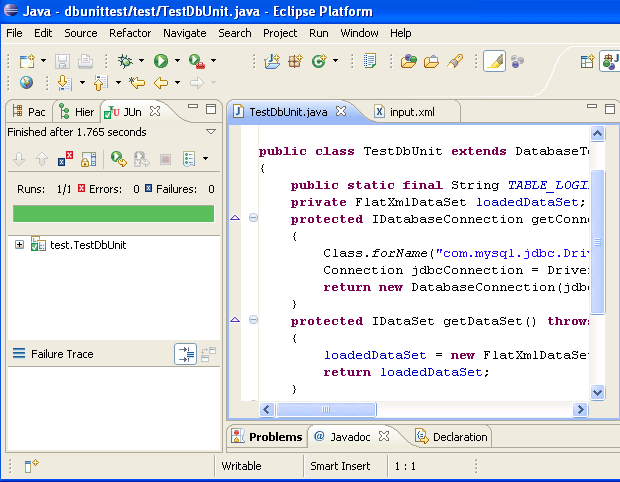Getting Started
We have used MySQL for database purpose. Now follow the steps below:
Create a table "login" in the
database "hrapptest" in MySQL like below :
login Table in database:
Field Type Collation Null Key Default ------------ ----------- ----------------- ------ ------ ------- id bigint(20) (NULL) NO PRI empcode varchar(15) latin1_swedish_ci YES (NULL) loginname varchar(30) latin1_swedish_ci NO password varchar(30) latin1_swedish_ci NO loginenabled varchar(1) latin1_swedish_ci NO |
Create XML file (for example, "input.xml")
representing the database tables and
the data within it. Put a data set in this file like below.
In this file "login" is the table name in the database and "id",
"empcode" etc are the columns in the table. Put values for the fields in this file.
input.xml :
<?xml version='1.0' encoding='UTF-8'?>
<dataset>
<!--Login Table -->
<login id="1" empcode="E005" loginname="chandan"
password="chandan" loginenabled="y"/>
<login id="2" empcode="E006" loginname="deepak"
password="deepak" loginenabled="n"/>
</dataset>
DbUnit framework provides an abstract class named "DatabaseTestCase" which is a sub class of JUnit's "TestCase" class. So instead of creating a subclass of TestCase class we need to extend DatabaseTestCase class. This class provides two abstract methods "getConnection()" and "getDataSet()".
| IDatabaseConnection getConnection() throws Exception |
| protected IDataSet getDataSet() throws Exception. |
Because of its being an abstract class we need to implement these two methods:
TestDbUnit.java :
...........................
...........................
// Provide a connection to the database
protected IDatabaseConnection getConnection() throws Exception{
Class driverClass = Class.forName("com.mysql.jdbc.Driver");
Connection jdbcConnection =
DriverManager.getConnection("jdbc:mysql://localhost:
3306/hrapptest", "root", "root");
return new DatabaseConnection(jdbcConnection);
}
// Load the data which will be inserted for the test
protected IDataSet getDataSet() throws Exception{
loadedDataSet =
new FlatXmlDataSet(this.getClass().getClassLoader().
getResourceAsStream("input.xml"));
return loadedDataSet;
}
............................
............................
|
getConnection() method returns IDatabaseConnection object that
represents database connection created using
DriverManager class. In the above code, IDatabaseConnection represents
MySQL
database where hrapptest is the name of database where username and
password
both are "deepak".
getDataSet() method uses the FlatXmlDataSet class to load "input.xml"
file and return this loaded data set as an object implementing IDataSet
interface. IDataSet provides many useful methods to return data sets.
Writing Test :
Now, write test to check that the data has been loaded in TestDbUnit.java
file:
............................
............................
public void testCheckLoginDataLoaded() throws Exception{
assertNotNull(loadedDataSet);
int rowCount = loadedDataSet.getTable(TABLE_LOGIN).getRowCount();
assertEquals(2, rowCount);
}
............................
............................
|
Combining all of the above functionalities into one
TestDbUnit.java
file, you will find it as follows :
TestDbUnit.java :
package test;
import java.sql.Connection;
import java.sql.DriverManager;
import org.dbunit.DatabaseTestCase;
import org.dbunit.database.DatabaseConnection;
import org.dbunit.database.IDatabaseConnection;
import org.dbunit.dataset.IDataSet;
import org.dbunit.dataset.xml.FlatXmlDataSet;
public class TestDbUnit extends DatabaseTestCase{
public static final String TABLE_LOGIN = "login";
private FlatXmlDataSet loadedDataSet;
// Provide a connection to the database
protected IDatabaseConnection getConnection() throws Exception{
Class.forName("com.mysql.jdbc.Driver");
Connection jdbcConnection =
DriverManager.getConnection("jdbc:mysql://localhost:3306/hrapptest",
"root", "root");
return new DatabaseConnection(jdbcConnection);
}
// Load the data which will be inserted for the test
protected IDataSet getDataSet() throws Exception{
loadedDataSet =
new FlatXmlDataSet(this.getClass().getClassLoader()
.getResourceAsStream("input.xml"));
return loadedDataSet;
}
// Check that the data has been loaded.
public void testCheckLoginDataLoaded() throws Exception{
assertNotNull(loadedDataSet);
int rowCount = loadedDataSet.getTable(TABLE_LOGIN).getRowCount();
assertEquals(2, rowCount);
}
}
|
Running Test :
Now, in Eclipse, go to Run->Run As and click "JUnit
Test" to run tests. If testing is successful then a green strip appears
at the left of the eclipse window. If any of the test fails then it turns into a red strip indicating
failure of any test.


